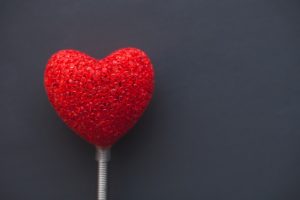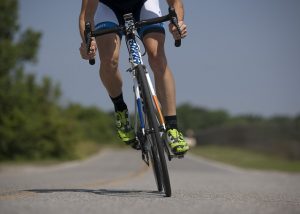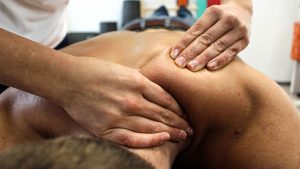- Integrated Body Therapies
Christine A. Ruppert, LMT5712 Stillwell Road
Rockville, MD 20851301-231-8695
Massage
Can Massage Therapy Offer Relief of Regional Pain Syndrome?
Regional pain syndrome, also known as reflex sympathetic dystrophy, is a chronic disease that’s characterized by long-lasting severe pain, swelling, and discoloration of the skin. In some cases, it may only affect a limb, but roughly a third of people who suffer from this disease report symptoms throughout their body. Whether you suffer from localized symptoms or whole-body symptoms, you can find relief through massage therapy. continue reading
The Text Neck Epidemic
Too much texting may be more than just a compulsive distraction.
New research suggests that constantly tilting your head to look down at a smartphone may result in severe neck strain. The human head generally weighs from 10 to 12 pounds, but back surgeon Kenneth Hansraj wanted to measure the variations in the amount of force exerted on the spine as the head bends forward. Using computer models, he found that a head bowed at a 15-degree angle adds roughly 27 pounds of pressure on the spine. But when the angle increases to 60 degrees – a typical angle at which an upright person would look at a phone in his hand – that strain surges to 60 pounds, or roughly the weight of four bowling balls. The extra strain can cause neck cramps, pinched nerves, herniated discs, and early degeneration of the spine. “The problem is really profound in young people,”
Hansraj tells Washington Post.com. “Just look around you – everyone has their heads down.” (The WEEK December 5, 2014)
Massage and neuromuscular therapy strategies to release neck, head and shoulder muscles can bring the head back to normal alignment over the trunk and thereby alleviate much of the pain associated with “Text Neck”.
2016 Health Studies
Exercise could help your brain stay young and lower your chances of cancer. In a study involving about 900 adults, those who did little or no regular physical activity experienced cognitive decline equivalent to 10 more years of aging compared with their more active peers. Early take-up was important: Exercise didn’t appear to help people who were already showing signs of cognitive decline. Another study found that people who do the equivalent of about two and a half hours of walking a week have a lower risk for 13 different forms of cancer. “If people understand that physical activity can influence their risk for cancer,” says lead author Steven Moore, “then that might provide yet one more motivating factor to become active.”
Carbs may not be so bad after all. While it is widely assumed that a high-carb diet leads to weight gain, researchers who looked into the eating habits of more than 23,000 Italians found that those who ate more pasta actually tended to have a lower body mass index. They speculated that pasta eaters were more likely to follow the Mediterranean diet, which is heavy on fruit, vegetables, and other healthy foods. Separate research concluded that carb-rich whole grains like oats and quinoa also have significant health benefits: Adults who ate three or more daily servings had a 20 percent lower risk of dying early. “Multiple individual studies consistently revealed a reduced risk of early death among people who consumed more whole grains,” says senior author Qi Sun.
Cutting calories may improve your entire quality of life, not just your waistline. In a small study, a group of healthy, non-obese adults reduced their daily calorie intake by 12 percent for two years. Not only did they lose an average of 17 pounds, they also enjoyed improved sleep, better moods, and an enhanced sex drive. Once people “get over the hump” and start dropping pounds, says co-author Corby Martin, “their hunger levels subside a bit and they start to feel the benefits of the weight loss.”
Friends and family can be as important to your health as diet and exercise. A University of North Carolina study found that social isolation increases risk of high blood pressure more than diabetes, and that lonely people are 30 percent more likely to suffer a heart attack or stroke than those who are socially active. Friends can “buffer some of the effects of stress, and/or help with coping,” says lead author Kathleen Mullan Harris. Separate research suggested that older people tend to live longer when they count a family member other than their spouse among their closest confidants.
Suffering from Edema? Try Massage Therapy
Edema, also known as hydroposy, is a medical condition in which an excessive amount of fluid accumulates beneath the skin. If you fall and hit your knee, for instance, fluid may fill the joint to the point where it causes severe pain, discomfort and limited mobility. During the natural and normal healing process, the body will reabsorb this fluid and full mobility will be restored. In some cases, however, swelling and fluid retention may persist, and massage therapy can be a very beneficial strategy to help decrease this excess fluid. continue reading
Massage Therapy Can Help Reduce Winter Blues
One in five Americans are impacted by seasonal change
Massage therapy shown to improve mood and elevate energy levels
People looking to fend off the winter blues may find relief by integrating massage therapy into their health maintenance routine. Shorter days and colder temperatures leave many Americans feeling depressed and lethargic, yet studies show that regular massages improve mood and reset circadian rhythms, leading to better sleep and more energy.
Seasonal Affective Disorder, or SAD, is recognized as a major depressive disorder with seasonal patterns. A less severe form of seasonal mood disorder, known as the winter blues, impacts an even larger portion of the population. Combined, the two disorders affect as many as one in five Americans, and may be aggravated by the change to Daylight Savings Time. Symptoms include reduced energy, difficulty rising in the morning and a tendency to eat more, especially sweets and starches.
“As we approach the colder, darker months, massage therapy may be an effective method of deflecting common seasonal challenges,” said Jeff Smoot, President of the American Massage Therapy Association (AMTA). “Massage benefits the way our bodies react to negative influences, whether that’s weather, anxieties or disorders.” Source: www.amtamassage.org
Massage for Anxiety & Depression
A growing body of research is documenting the impact of massage therapy for relief of anxiety and depression for people in a wide range of health situations. For example, in a controlled study composed of HIV-positive adolescents, participants who received massage therapy reported feeling less anxious and less depressed by the end of the 12-week study.
A randomized study found women with stage 1 and 2 breast cancer benefited from regular massage therapy sessions. The immediate massage benefits included reduced anxiety, depressed mood and anger while the long-term impact reduced depression and increased serotonin values. Serotonin, a neurotransmitter with functions in various parts of the body, works to regulate mood, appetite, sleep, memory and learning. Massage therapy was also found to improve sleep, specifically by assisting with circadian rhythms, or the body clock. A study investigating the effects of massage therapy on the adjustment of rest to activity, as well as melatonin secretion rhythms in full-term infants, found massage therapy enhanced coordination of the circadian system.
Source: www.amtamassage.org
Can Massage Therapy Promote a Healthy Heart?
 Massage therapy is used to treat and prevent a wide range of diseases and adverse conditions, including stress, muscle tension, pain, inflammation and more. It’s a safe, non-invasive practice that has become increasingly popular for this very reason. You may be surprised to learn that massage therapy can also yield benefits for heart health.
Massage therapy is used to treat and prevent a wide range of diseases and adverse conditions, including stress, muscle tension, pain, inflammation and more. It’s a safe, non-invasive practice that has become increasingly popular for this very reason. You may be surprised to learn that massage therapy can also yield benefits for heart health.
Even with the advancements made in modern medicine, heart disease remains the leading cause of death among men and women in the United States. According to the Centers for Disease Control and Prevention (CDC), an estimated 600,000 people in the U.S. die from heart disease each year. While diet and exercise can lower a person’s risk of developing heart disease, there is strong evidence indicating that massage therapy can help as well. continue reading
Massage to Improve Sleep & Reduce Stress
Massage therapy has been shown to reduce the symptoms of stress, depression and anxiety. It’s excellent for reducing insomnia, and has been shown to improve both the ability to fall asleep and the duration of sleep, allowing for otherwise anxious individuals to rest. The lack of ability to sleep plays a key role in the development and exacerbation of these conditions and creates a downward spiral of despair. By interrupting the insomnia cycle, massage can play a huge role in reducing emotion-based conditions.
Source: www.naturalwellness.com
Benefits of Massage Therapy for a Pulled Muscle
 A pulled muscle, or muscle strain, is among the most common types of injuries sustained by athletes and bodybuilders. It’s characterized by the physical tearing (full or partial) of muscle fibers and/or its connected tendons, usually occurring during a strenuous activity. While most pulled muscles will heal on their own without the need for professional medical assistance, seeking massage therapy can speed up the healing process.
A pulled muscle, or muscle strain, is among the most common types of injuries sustained by athletes and bodybuilders. It’s characterized by the physical tearing (full or partial) of muscle fibers and/or its connected tendons, usually occurring during a strenuous activity. While most pulled muscles will heal on their own without the need for professional medical assistance, seeking massage therapy can speed up the healing process.
Before we reveal the healing power of massage therapy, let’s first discuss the signs and symptoms of a pulled muscle. While no cases are the same, some of the most commonly reported symptoms of a pulled muscle include throbbing pain, swelling, redness, weakness, and/or limited mobility. continue reading
Top 5 Reasons to Consider Massage Therapy
 Lowers Stress Levels
Lowers Stress Levels
Feeling overly stressed about your job, relationships, finances, or health? If so, you may want to consider massage therapy. This treatment has been shown to have an almost immediate benefit on stress levels, relieving stress and anxiety while encouraging greater relaxation.
Improves Muscle Recovery
Another common reason why people seek massage therapy is to improve muscle recovery. When you lift weights or perform other high-intensity interval training (HIIT) exercises, it creates small tears in muscle fiber, which is essentially why you feel sore afterwards. When the muscle is massaged, it stimulates blood flow to the region, allowing it to heal in less time. And when your muscle tissue heals in less time, you can get back in the gym rather than sitting around the house. continue reading
